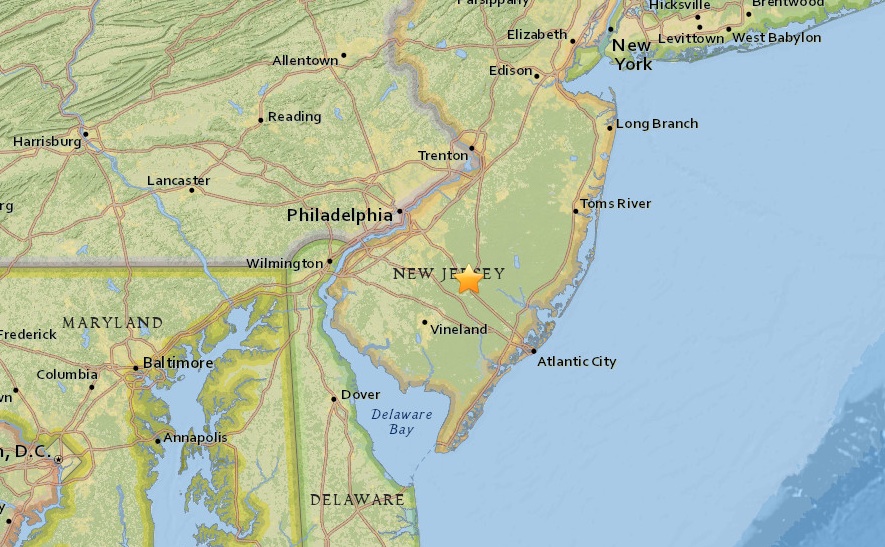F-35 Fighter Jet Likely Caused Sonic Booms That Rocked New Jersey

The sonic booms that rattled residents of New Jersey up to Long Island, New York, yesterday may have been the result of fighter jet flight tests at the Naval Air Station in Patuxent River, Maryland.
At 1:24 p.m. EST (18:24:05 UTC) about 2 miles (3 kilometers) north-northeast of Hammonton, New Jersey, and 37 miles (60 km) south of Trenton, New Jersey, a sonic boom was detected at nearby seismometers in the ground. At least nine others were picked up in the following hour and a half along the Eastern Seaboard up to Long Island, according to the U.S. Geological Survey (USGS).
The speed of the seismic waves and other factors identified the events as sonic booms and not earthquakes, according to John Bellini, a geophysicist with the USGS National Earthquake Information Center in Golden, Colorado.
When an object such as an aircraft (or an explosion) travels faster than the speed of sound (761.2 mph, or 1,225 km/h, at sea-level), the result is a shockwave that also travels faster than sound, Bellini told Live Science. [Photos: See Aircraft Breaking the Sound Barrier]
Potential culprits were ruled out soon after the booms were recorded, with officials at NASA's Wallops Flight Facility on Wallops Island in Virginia confirming there weren't any rocket launches or jet flights at the center that could have caused the sonic booms. The Federal Aviation Administration and the North American Aerospace Defense Command both also confirmed no nearby planes operating that may have caused the sonic booms, as reported by ABC News yesterday.
A nearby naval base was also cleared: "We have reports of ground shaking in S. Jersey-- currently our training ranges are clear and no MDL aircraft are capable of sonic booms," officials at Joint Base McGuire-Dix-Lakehurst wrote on Twitter. "We're working with local authorities to determine the cause and will have an update ASAP."
But late in the afternoon, the U.S. Navy released a statement about flight testing in the area.
Get the world’s most fascinating discoveries delivered straight to your inbox.
"Aircraft from Naval Test Wing Atlantic were conducting routine flight testing in the Atlantic Test Ranges this afternoon that included activities which may have resulted in sonic booms,” the Navy said in a statement, as reported by the Washington Post. "The test wing is critical to the safe test and evaluation of all types of Navy and Marine Corps aircraft in service and in development and is primarily based out of Naval Air Station Patuxent River, Md. Other military aircraft, including both Navy and Air Force, also frequently use the ranges for testing and training."
The sonic-boom culprits were likely the F-18 and the F-35C, which were the craft involved in the flight testing, according to the Washington Post. The F-18, also called the F/A-18 Hornet, is a strike fighter used as both an attack aircraft and a fighter that has a max speed of Mach 1.8, or 1.8 times the speed of sound in air. The F-35C, a Joint Strike Fighter warplane designed to operate from the flight decks of aircraft carriers, can reach speeds of Mach 1.6, according to Lockheed Martin, the defense contractor that is developing the fighter jet.
"Thursday's sonic booms could well have been the result of a face-off between the F-35 and the older F-18 Hornet, a supersonic jet that the Navy has used since the mid 1980s," reported the Post.
Follow us @livescience, Facebook & Google+. Original article on Live Science.
Jeanna Bryner is managing editor of Scientific American. Previously she was editor in chief of Live Science and, prior to that, an editor at Scholastic's Science World magazine. Bryner has an English degree from Salisbury University, a master's degree in biogeochemistry and environmental sciences from the University of Maryland and a graduate science journalism degree from New York University. She has worked as a biologist in Florida, where she monitored wetlands and did field surveys for endangered species, including the gorgeous Florida Scrub Jay. She also received an ocean sciences journalism fellowship from the Woods Hole Oceanographic Institution. She is a firm believer that science is for everyone and that just about everything can be viewed through the lens of science.
